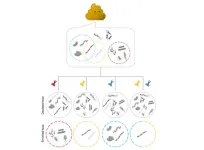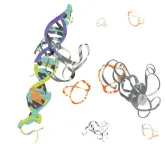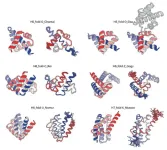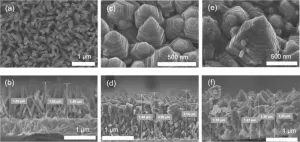(Press-News.org) Researchers from Amsterdam UMC and Vrije Universiteit Amsterdam (VU) have discovered that the persistent fatigue in patients with long-COVID has a biological cause, namely mitochondria in muscle cells that produce less energy than in healthy patients. The results of the study were published today in Nature Communications.
"We're seeing clear changes in the muscles in these patients," says Michèle van Vugt, Professor of Internal Medicine at Amsterdam UMC.
25 long-COVID patients and 21 healthy control participants participated in the study. They were asked to cycle for fifteen minutes. This cycling test caused a long-term worsening of symptoms in people with long-COVID, called post-exertional malaise (PEM). Extreme fatigue occurs after physical, cognitive, or emotional exertion beyond an unknown, individual threshold. The researchers looked at the blood and muscle tissue 1 week before the cycling test and 1 day after the test.
"We saw various abnormalities in the muscle tissue of the patients. At the cellular level, we saw that the mitochondria of the muscle, also known as the energy factories of the cell, function less well and that they produce less energy," says Rob Wüst, Assistant Professor at Department of Human Movement Sciences at the VU University. "So, the cause of the fatigue is really biological. The brain needs energy to think. Muscles need energy to move. This discovery means we can now start to research an appropriate treatment for those with long-COVID," adds van Vugt.
One of the theories about long-COVID is that coronavirus particles may remain in the body of people who have had the coronavirus. "We don't see any indications of this in the muscles at the moment," says Van Vugt. The researchers also saw that the heart and lungs functioned well in the patients. This means that the long-lasting effect on patient's fitness is not caused by abnormalities in the heart or lungs.
Exercising within your own limits
Exercising is not always good for patients with long-COVID. "In concrete terms, we advise these patients to guard their physical limits and not to exceed them. Think of light exertion that does not lead to worsening of the complaints. Walking is good, or riding an electric bike, to maintain some physical condition. Keep in mind that every patient has a different limit," says Brent Appelman, researcher at Amsterdam UMC. "Because symptoms can worsen after physical exertion, some classic forms of rehabilitation and physiotherapy are counterproductive for the recovery of these patients," van Vugt adds.
Long-COVID symptoms
Although the majority of people infected with the SARS-CoV-2 virus recover within weeks, a subgroup, estimated to be around one in eight, will get long-COVID. Symptoms in patients with long-COVID, post-acute sequelae or COVID or post-COVID syndrome (PCS) include severe cognitive problems (brain fog), fatigue, exercise intolerance, autonomic dysregulation, postural orthostatic tachycardia syndrome (POTS), orthostatic intolerance, and worsening of symptoms after PEM.
END
Tiredness experienced by Long-COVID patients has a physical cause
Research from Amsterdam shows that the feelings of fatigue in Long-COVID patients is causes by mitochondria that produce less energy
2024-01-04
ELSE PRESS RELEASES FROM THIS DATE:
New roles for autophagy genes in cellular waste management and aging
2024-01-04
Autophagy, which declines with age, may hold more mysteries than researchers previously suspected. In the January 4th issue of Nature Aging, it was noted that scientists from the Buck Institute, Sanford Burnham Prebys and Rutgers University have uncovered possible novel functions for various autophagy genes, which may control different forms of disposal including misfolded proteins—and ultimately affect aging.
“While this is very basic research, this work is a reminder that it is critical for us to understand whether we have the whole story about the different genes that have been related to aging or age-related diseases,” said Professor ...
The surprisingly resourceful ways bacteria thrive in the human gut
2024-01-04
The gut microbiome is so useful to human digestion and health that it is often called an extra digestive organ. This vast collection of bacteria and other microorganisms in the intestine helps us break down foods and produce nutrients or other metabolites that impact human health in a myriad of ways. New research from the University of Chicago shows that some groups of these microbial helpers are amazingly resourceful too, with a large repertoire of genes that help them generate energy for themselves and potentially influence human health as well.
The paper, published January 4, 2024, in Nature ...
Genomic ‘tweezer’ ushers in a new era of precision in microbiome research
2024-01-04
In a landmark study recently published in the journal Nature Methods, researchers at the Icahn School of Medicine at Mount Sinai have unveiled mEnrich-seq—an innovative method designed to substantially enhance the specificity and efficiency of research into microbiomes, the complex communities of microorganisms that inhabit the human body.
Unlocking the Microbial World with mEnrich-seq
Microbiomes play a crucial role in human health. An imbalance or a decrease in the variety of microbes in our bodies can lead to an increased risk of several diseases. However, in many microbiome applications, the focus is on studying specific ...
Scientists tame chaotic protein fueling 75% of cancers
2024-01-04
Meet MYC, the shapeless protein responsible for making the majority of human cancer cases worse. UC Riverside researchers have found a way to rein it in, offering hope for a new era of treatments.
In healthy cells, MYC helps guide the process of transcription, in which genetic information is converted from DNA into RNA and, eventually, into proteins. “Normally, MYC’s activity is strictly controlled. In cancer cells, it becomes hyper active, and is not regulated properly,” said UCR associate professor of chemistry Min Xue.
“MYC is less like food for cancer cells and more like a steroid ...
Breakthrough in designing complicated all-α protein structures
2024-01-04
A team of researchers has developed an innovative method to design complicated all-α proteins, characterized by their non-uniformly arranged α-helices as seen in hemoglobin. Employing their novel approach, the team successfully created five unique all-α protein structures, each distinguished by their complicated arrangements of α-helices. This capability holds immense potential in designing functional proteins.
This research has been published in the journal Nature Structural and Molecular Biology on January 4, 2024.
Proteins fold into unique three-dimensional structures based on their amino acid sequences, which then dictate their ...
Scientists solve mystery of how predatory bacteria recognizes prey
2024-01-04
A decades-old mystery of how natural antimicrobial predatory bacteria are able to recognize and kill other bacteria may have been solved, according to new research.
In a study published today (4th January) in Nature Microbiology, researchers from the University of Birmingham and the University of Nottingham have discovered how natural antimicrobial predatory bacteria, called Bdellovibrio bacterivorous, produce fibre-like proteins on their surface to ensnare prey.
This discovery may enable scientists to use these predators to target and kill ...
Scientists engineer plant microbiome for the first time to protect crops against disease
2024-01-04
Breakthrough could dramatically cut the use of pesticides and unlock other opportunities to bolster plant health
Scientists have engineered the microbiome of plants for the first time, boosting the prevalence of ‘good’ bacteria that protect the plant from disease.
The findings published in Nature Communications by researchers from the University of Southampton, China and Austria, could substantially reduce the need for environmentally destructive pesticides.
There is growing public awareness about the significance of our microbiome – the myriad of microorganisms that live in and around our bodies, most notably in our guts. Our gut ...
Chiba University is pleased to announce the International Conference: “Humanities In The Age Of Space Exploration”
2024-01-04
Introduction to the Event: As the world witnesses rapid technological advancements and the increasing reality of space travel and habitation, Chiba University is taking the lead in shaping the dialogue on the future of space development and humanity. The upcoming conference will feature distinguished speakers from Chiba University and international institutions, converging to facilitate interdisciplinary discussions. Through diverse lenses encompassing philosophy, ethics, law, political science, and horticulture, the conference aims to gain profound insights, welcoming active ...
US study offers a different explanation why only 36% of psychology studies replicate
2024-01-04
In light of an estimated replication rate of only 36% out of 100 replication attempts conducted by the Open Science Collaboration in 2015 (OSC2015), many believe that experimental psychology suffers from a severe replicability problem.
In their own study, recently published in the open-access peer-reviewed scientific journal Social Psychological Bulletin, Drs Brent M. Wilson and John T. Wixted at the University of California San Diego (USA) suggest that what has since been referred to as a “replication crisis” might not be as bad as it seems.
“No one asks a critical question,” the scientists argue, “if ...
Development of zinc oxide nanopagoda array photoelectrode
2024-01-04
Overview
A research team consisting of members of the Egyptian Petroleum Research Institute and the Functional Materials Engineering Laboratory at the Toyohashi University of Technology, has developed a novel high-performance photoelectrode by constructing a zinc oxide nanopagoda array with a unique shape on a transparent electrode and applying silver nanoparticles to its surface. The zinc oxide nanopagoda is characterized by having many step structures, as it comprises stacks of differently sized hexagonal prisms. In addition, it exhibits very few crystal defects and excellent electron conductivity. By decorating its surface with silver nanoparticles, the zinc oxide nanopagoda ...
LAST 30 PRESS RELEASES:
Human adipose tissue: a new source for functional organoids
Metro lines double as freight highways during off-peak hours, Beijing study shows
Biomedical functions and applications of nanomaterials in tumor diagnosis and treatment: perspectives from ophthalmic oncology
3D imaging unveils how passivation improves perovskite solar cell performance
Enriching framework Al sites in 8-membered rings of Cu-SSZ-39 zeolite to enhance low-temperature ammonia selective catalytic reduction performance
AI-powered RNA drug development: a new frontier in therapeutics
Decoupling the HOR enhancement on PtRu: Dynamically matching interfacial water to reaction coordinates
Sulfur isn’t poisonous when it synergistically acts with phosphine in olefins hydroformylation
URI researchers uncover molecular mechanisms behind speciation in corals
Chitin based carbon aerogel offers a cleaner way to store thermal energy
Tracing hidden sources of nitrate pollution in rapidly changing rural urban landscapes
Viruses on plastic pollution may quietly accelerate the spread of antibiotic resistance
Three UH Rainbow Babies & Children’s faculty elected to prestigious American Pediatric Society
Tunnel resilience models unveiled to aid post-earthquake recovery
Satellite communication systems: the future of 5G/6G connectivity
Space computing power networks: a new frontier for satellite technologies
Experiments advance potential of protein that makes hydrogen sulfide as a therapeutic target for Alzheimer’s disease
Examining private equity’s role in fertility care
Current Molecular Pharmacology achieves a landmark: real-time CiteScore advances to 7.2
Skeletal muscle epigenetic clocks developed using postmortem tissue from an Asian population
Estimating unemployment rates with social media data
Climate policies can backfire by eroding “green” values, study finds
Too much screen time too soon? A*STAR study links infant screen exposure to brain changes and teen anxiety
Global psychiatry mourns Professor Dan Stein, visionary who transformed mental health science across Africa and beyond
KIST develops eco-friendly palladium recovery technology to safeguard resource security
Statins significantly reduce mortality risk for adults with diabetes, regardless of cardiovascular risk
Brain immune cells may drive more damage in females than males with Alzheimer’s
Evidence-based recommendations empower clinicians to manage epilepsy in pregnancy
Fungus turns bark beetles’ defenses against them
There are new antivirals being tested for herpesviruses. Scientists now know how they work
[Press-News.org] Tiredness experienced by Long-COVID patients has a physical causeResearch from Amsterdam shows that the feelings of fatigue in Long-COVID patients is causes by mitochondria that produce less energy





